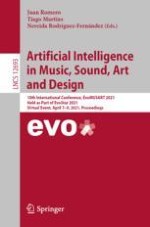2021 | OriginalPaper | Chapter
“What Is Human?” A Turing Test for Artistic Creativity
Authors : Antonio Daniele, Caroline Di Bernardi Luft, Nick Bryan-Kinns
Published in: Artificial Intelligence in Music, Sound, Art and Design
Publisher: Springer International Publishing
Activate our intelligent search to find suitable subject content or patents.
Select sections of text to find matching patents with Artificial Intelligence. powered by
Select sections of text to find additional relevant content using AI-assisted search. powered by
